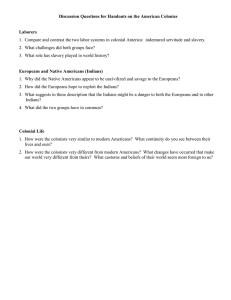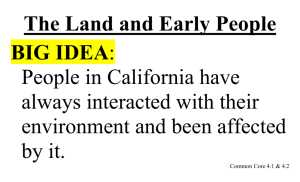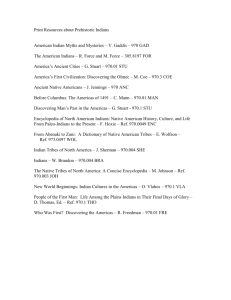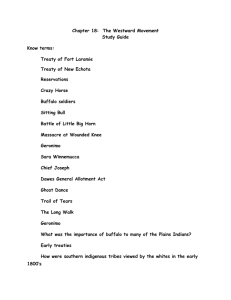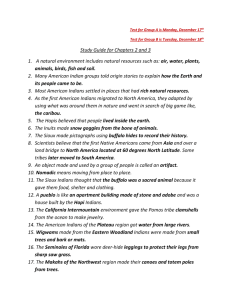#2 USA EARLY HISTORY: NATIVE AMERICANS
advertisement
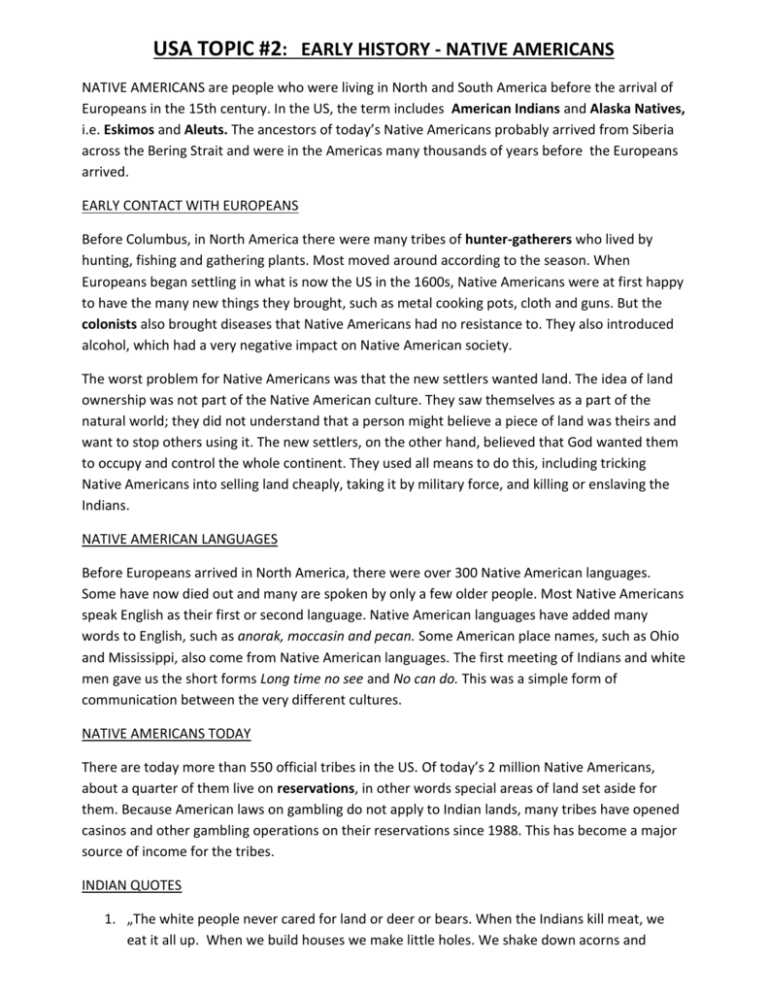
USA TOPIC #2: EARLY HISTORY - NATIVE AMERICANS NATIVE AMERICANS are people who were living in North and South America before the arrival of Europeans in the 15th century. In the US, the term includes American Indians and Alaska Natives, i.e. Eskimos and Aleuts. The ancestors of today’s Native Americans probably arrived from Siberia across the Bering Strait and were in the Americas many thousands of years before the Europeans arrived. EARLY CONTACT WITH EUROPEANS Before Columbus, in North America there were many tribes of hunter-gatherers who lived by hunting, fishing and gathering plants. Most moved around according to the season. When Europeans began settling in what is now the US in the 1600s, Native Americans were at first happy to have the many new things they brought, such as metal cooking pots, cloth and guns. But the colonists also brought diseases that Native Americans had no resistance to. They also introduced alcohol, which had a very negative impact on Native American society. The worst problem for Native Americans was that the new settlers wanted land. The idea of land ownership was not part of the Native American culture. They saw themselves as a part of the natural world; they did not understand that a person might believe a piece of land was theirs and want to stop others using it. The new settlers, on the other hand, believed that God wanted them to occupy and control the whole continent. They used all means to do this, including tricking Native Americans into selling land cheaply, taking it by military force, and killing or enslaving the Indians. NATIVE AMERICAN LANGUAGES Before Europeans arrived in North America, there were over 300 Native American languages. Some have now died out and many are spoken by only a few older people. Most Native Americans speak English as their first or second language. Native American languages have added many words to English, such as anorak, moccasin and pecan. Some American place names, such as Ohio and Mississippi, also come from Native American languages. The first meeting of Indians and white men gave us the short forms Long time no see and No can do. This was a simple form of communication between the very different cultures. NATIVE AMERICANS TODAY There are today more than 550 official tribes in the US. Of today’s 2 million Native Americans, about a quarter of them live on reservations, in other words special areas of land set aside for them. Because American laws on gambling do not apply to Indian lands, many tribes have opened casinos and other gambling operations on their reservations since 1988. This has become a major source of income for the tribes. INDIAN QUOTES 1. „The white people never cared for land or deer or bears. When the Indians kill meat, we eat it all up. When we build houses we make little holes. We shake down acorns and pinenuts. But the white people plow up the ground, pull down trees, kill everything. The tree says „Don’t. I am sore. Don’t hurt me.” But they chop it down and cut it up. The Indians never hurt anything, but the white people destroy everything. How can the spirit of the earth like the White man? Everywhere the White man has touched it, it is sore.” The Wintu Indians of California 2. The Tipi is much better to live in – always clean, warm in winter, cool in summer – easy to move. The white man builds big house, cost much money, like big cage, shut out sun, can never move; always sick. Indians and animals know better how to live than white man; nobody can be in good health if he does not have all the time fresh air, sunshine and good water. If the Great Spirit wanted man to stay in one place he would make the world stand still. The white man does not obey the Great Spirit; that is why the Indians never could agree with him. Chief Flying Hawk, a Sioux Indian, nephew of Sitting Bull (1852-1931). He fought at Little Big Horn. Pueblo Indian ruins a totem pole TASK: WRITE 8 LINES COMPARING INDIAN LIFE AND VALUES TO THE WHITE MAN’S: __________________________________________________________________________ __________________________________________________________________________ __________________________________________________________________________ __________________________________________________________________________ __________________________________________________________________________ __________________________________________________________________________ __________________________________________________________________________ __________________________________________________________________________ From Oxford Guide to British and American Culture + JG
